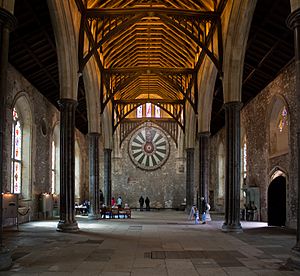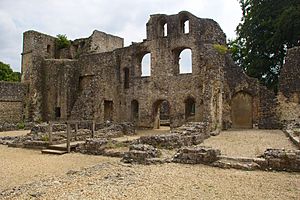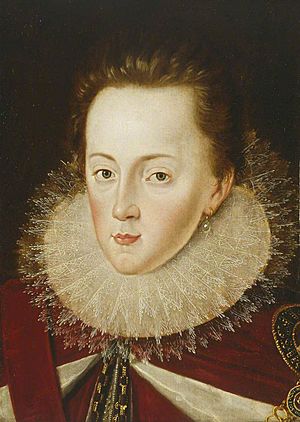Prince Henry's Welcome at Winchester facts for kids
Prince Henry's Welcome at Winchester was a special show called a masque. It was put on by Anne of Denmark, who was the Queen, in 1603. The show happened in Winchester sometime between October 11 and 17. Masques were popular plays with music, dancing, and costumes, often performed for royalty.
A Royal Welcome in Winchester


In 1603, Henry Frederick, Prince of Wales was the son of James VI and I and Queen Anne of Denmark. After Queen Elizabeth I passed away, James became the new King of England. This event is known as the Union of the Crowns, as it joined the crowns of Scotland and England.
Prince Henry and his sister, Princess Elizabeth, came to live in England. Princess Elizabeth first stayed at Oatlands Palace. However, a serious outbreak of the plague hit London in June. To keep the royal children safe, they were moved. After a servant died from the plague in August, Princess Elizabeth joined Prince Henry at Nonsuch Palace.
In September, two more people in the Queen's household died from the plague. Because of this, Henry and Elizabeth were moved again, this time to Winchester Castle. Winchester was believed to be a healthier and safer place.
Queen Anne of Denmark arrived in Winchester on September 17, 1603. She and King James met with the Spanish ambassador, the Count of Villamediana, in Winchester on September 24.
The masque was performed to welcome Prince Henry. He arrived in Winchester on October 11, and this might have been the day the show took place. On October 17, as Queen Anne was moving to Wilton House, a man named Thomas Edmondes wrote that the Queen had put on a "gallant mask" for her son. This shows how special the event was for Prince Henry.
Court Entertainment During Difficult Times
Not many details are known about the masque from October 1603. However, it was mentioned in several news reports at the time. The name Prince Henry's Welcome at Winchester was given to the event later.
Some famous people might have been involved. The musician John Dowland mentioned meeting the Queen in Winchester in one of his writings. Thomas Cardell, a lute player and dance teacher, was with the Queen and Princess Elizabeth. The Queen's secretary, a poet named William Fowler, was also in Winchester. He had previously written shows for Prince Henry's baptism in 1594.
Arbella Stuart, a cousin of King James, was there and wrote about the masque. She called it an "interlude" and even joked that it was "ridiculous." She also mentioned that the Queen's household played children's games in their Winchester lodging.
Lady Anne Clifford had visited Prince Henry earlier in October. She later heard about the masque at Winchester. Lady Anne recalled that some people thought the masque had harmed the reputation of Anne of Denmark and the women of her court. She said there was "much talk" that the court had become a "scandalous place." This might have been because the Queen and her ladies took part in the masque or danced themselves, which some people at the time found unusual or improper for royalty.
Some of the ladies in the Queen's household at Winchester might have included Anna Livingstone, Margaret Stewart, Anna Campbell, Jean Drummond, and Margaret Hartsyde. Margaret Stewart had danced in another show in September 1603.
Planning Future Royal Shows
The masque in Winchester was also talked about in connection with plans for future court parties. The French ambassador, Christophe de Harlay, Count of Beaumont, said the Winchester show was "rustic," meaning it was simple rather than fancy. He felt it helped cheer up the Queen.
Queen Anne was already planning bigger and more expensive shows for the future. These later shows included The Masque of Indian and China Knights and The Vision of the Twelve Goddesses. The Winchester masque seems to have been a more personal event for her son, Prince Henry, rather than a grand show for important visitors.
Dudley Carleton mentioned plans for Christmas at Windsor Castle. He noted that "many plays and shows are bespoken" to entertain the ambassadors. Thomas Edmondes wrote that the Queen's preparations needed "invention" and help from Hugh Sanford, who was a tutor to the Earl of Pembroke.
Making the ambassadors happy was very important at this time. Another French ambassador had already complained about a gift he received from the King. Lord Cecil was worried that the Spanish and French ambassadors might feel they were not treated as well as others.


